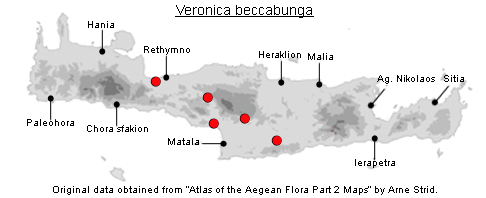SPECIES DESCRIPTION
VERONICA BECCABUNGA
Family and Genus:- See- PLANTAGINACEAE/Sect. BECCABUNGA
Common Names:- Brooklime
Homotypic Synonyms:- None
Meaning:- Veronica (L) For Saint Veronica, who wiped the sweat from Christ's
face.
Beccabunga(L) From an old German name 'bachbungen', mouth-
smart or streamlet-blocker.
General description:- Glabrous perennial.
Stem:-
1) Decumbent, rooting at the nodes.
Leaves:-
1) 10-40 mm, thick, orbicular, ovate or oblong, obtuse, petiolate, subentire or
crenate-serrate.
Flowers:-
1) Racemes, up to 3 times as long as subtending leaves.
2) Bracts, from half as long to twice as long as the pedicels.
3) Calyx-segments, more or less deflexed in fruit.
4) Corolla, 5-7 mm diam, pale to dark blue (rarely pinkish).
5) Style c. 2 mm.
Fruit:-
1) Capsule, 2-3 x 2-4 mm, subglobose, scarcely emarginate, scarcely compressed,
both septicidal and loculicidal, dehiscing into four valves.
2) Seeds, scarcely compressed, with excentric chalaza.
Key features:-
1) Flowers in axillary racemes (which, if single and near the stem-apex, may appear
terminal)
2) Capsule, scarcely compressed, both septicidal and loculicidal, dehiscing into
four valves.
3) Seeds, scarcely compressed, with excentric chalaza.
4) Flowering stems, procumbent or ascending.
5) Leaves, thick all petiolate.
Habitat:- Usually semi-aquatic in running water, sometimes in ditches, wet
meadows and other marshy habitats. 0-900 m.
Distribution:- Throughout Greece, mainly in the mountains. - A widespread Euro-
Siberian species. Limited distribution across Crete, mainly in the central areas.
Flowering time:- Late Apr to July, sometimes later.
Photos by:- Courtesy of Wiki-Commons
